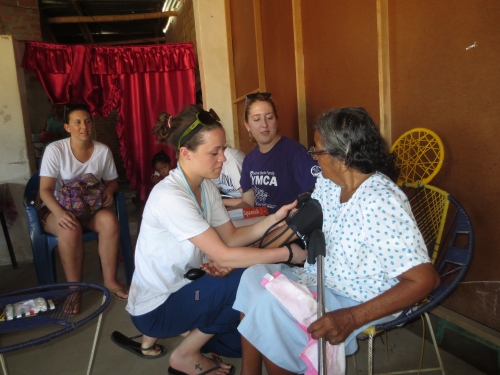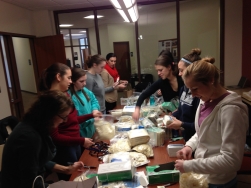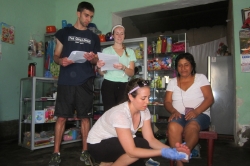An eye opening education in Peru
During the second semester of their senior year, Villanova University College of Nursing students had the opportunity to apply for an international site for their Health Promotion Clinical. There were three international options for the spring of 2014 - Nicaragua, Ghana or Peru.

Chulucanas, Peru is a small desert town in northern Peru near the border of Ecuador. The College of Nursing has a longstanding relationship with this community that began in 1999. The focus of the clinical practicum is population assessment and education of the population around health problems and disease management. The students and faculty begin their work by determining the leading health problems of the community and examining the culture and social, political and resources available to the community and their impact on health. This extensive preparation culminates with their in-country time during spring break.

Sorting donated supplies
Maureen Lynch, senior nursing student, also organized a fundraising website to raise money to donate much needed healthcare supplies to the community. “Through the website, $2,000.00 was raised for items including blood pressure cuffs, stethoscopes, wound care supplies, and other basic first aid supplies, all of which were given to the community health volunteers in Chulucanas,” notes senior Kathryn Magargee, student trip leader. An integral part of the work planned for this year was a workshop on the first day of the visit that included the continued instruction of the community health volunteers on how to perform blood pressure measurements, post-operative care and basic assessment skills. “We taught the community health volunteers with the intention and the hope that care for the community members would continue long after our departure,” explains Kathryn.
After extensively researching the community health needs in the three main Chulucanas parishes of San Ramon, San Jose Obrero, and Sagrada Familia, students realized food accessibility issues and lack of healthcare access were two of the main factors contributing to health disparities within the community. The four health topics that were most pertinent to the community of Chulucanas for this visit were management and prevention of diabetes, care of the pregnant adolescent, first aid and post-operative care, and domestic violence. “Student pairs presented their topics to a different community each afternoon,” notes Dr. Bette Mariani, assistant professor.

The presentations were very well received by the community. Students also had the opportunity to use their assessment skills by accompanying community health volunteers on home visits each morning. “It was a great eye opener to experience such a different way of living first hand,” says senior Maureen Lynch. Dr. Mariani notes that this provided an opportunity for students to realize how much they have learned and already know. “It’s great for the students to draw upon the knowledge they have gained throughout the course of their education. They are forced to utilize their knowledge and skills without all of the technical resources that are available in most of our clinical sites,” she adds.
Although students were taken outside of their comfort zone, their experience was positive. “Living simply in a rural community thousands of miles from home was daunting at first. However, building relationships with the Chulucanas community, as well as with members of our own Villanova community was very rewarding,” offers Kathryn. Students may have viewed countless pictures, extensively researched the community, and interviewed others who undertook the journey before them, however, nothing compares to experiencing the trip first hand. Maureen notes that the education that she and her classmates shared with the residents was well received, and says “No image or number could prepare me for the extreme poverty, the stifling heat, and the lack of resources that is the everyday reality for the people of Chulucanas. However, the gratitude, joy, hope and resilience among members of the community made it all worth it.”
